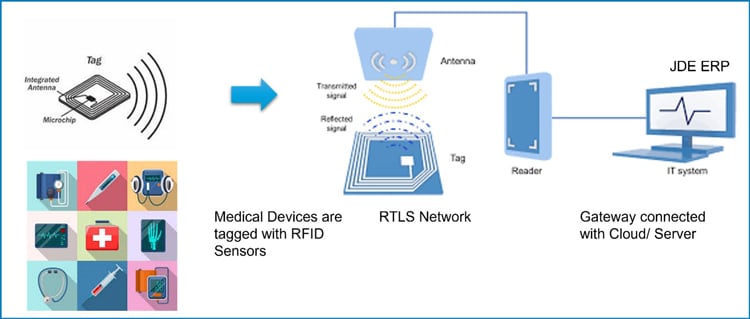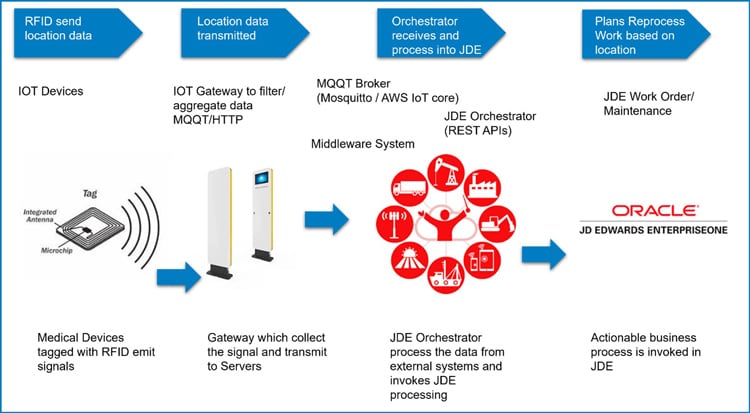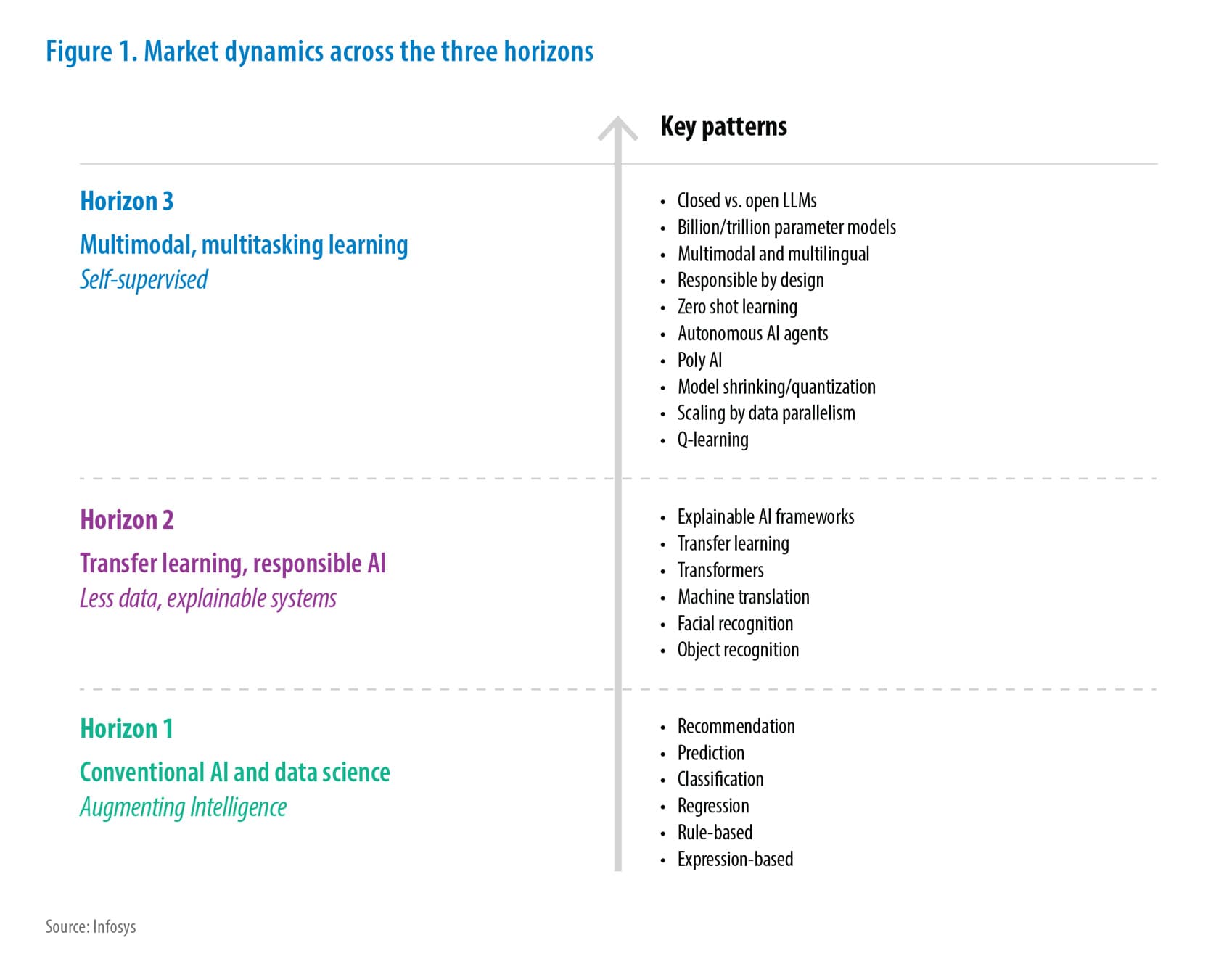Digital Supply Chain
Real-Time Visibility in Medical Supply Chains using IoMT (Internet of Medical Things) and Oracle JD Edwards Integration
Medical devices, when manufactured, pass through various stages of the supply chain before reaching the end customer. Contract manufacturers face significant challenges in tracking these devices due to the involvement of multiple entities, systems, and partners. Robust tracking mechanisms are essential to resolve issues, enable device reprocessing for sustainability, reduce patient risks, and improve safety.
IoMT (Internet of Medical Things) can be integrated with Oracle JD Edwards to track medical devices that require high traceability across the supply chain. This paper explores real-time data integration using the IoT Orchestrator, which transforms raw data from medical devices into actionable insights within the JD Edwards ERP system. It also discusses service request creation, rule-based processing, and cross-reference mapping of IoT data in JD Edwards Orchestrator to enhance decision-making.
Insights
- Remote Patient Monitoring – IoMT enables monitoring of patient vitals (e.g., heart rate, blood pressure) from any location. This allows doctors to manage multiple patients simultaneously and access real-time data.
- Smart Wearables – These devices track patient health data and provide timely insights. They can remind users to take medications and alert them to seek hospital care before emergencies arise.
Introduction
IoMT is an advanced form of IoT (Internet of Things) that refers to a network of interconnected medical devices and applications that continuously exchange health and medical data. It transforms patient care, enhances medical device reusability, improves clinical outcomes, and supports device reprocessing.
The IoMT market is rapidly expanding and is projected to reach $176 billion by 2026. This growth is driven by the increasing adoption of connected devices, advancements in wireless technologies, and the demand for efficient healthcare solutions. This paper presents an Oracle JD Edwards (JDE)-based solution for enabling IoMT, thereby integrating medical devices with JDE applications.
Medical Devise Tracking
Medical device tracking involves monitoring and identifying devices throughout their lifecycle—from manufacturing to distribution and patient use. By implementing end-to-end system integration using Oracle JD Edwards IoT Orchestrators, manufacturers can quickly address product defects and track devices across supply chain phases.
This requires defining unique lot/serial numbers and product barcodes to ensure traceability. Devices can be recalled if necessary, ensuring patient safety. Additionally, knowing the device’s location helps plan for reuse and optimize inventory.
Real-time Location Systems (RTLS)
RTLS provides real-time visibility into device location and status, offering an accurate picture of usage, reprocessing needs, and inventory levels. RTLS systems include:
- Tags and Sensors: Attached to medical devices and emit signals that can be detected by the RTLS. Tags can use various technologies such as RFID, Bluetooth Low Energy (BLE), or Wi-Fi.
- Readers and Antennas: They are Strategically placed to receive signals from tags and sensors and determine device location using triangulation or signal strength.
- Connectivity: RFID gateways enable bi-directional communication between tags and the central system.
- Software Platform: Processes data from readers and integrates with ERP systems like Oracle JD Edwards.
Figure 1: RFID Sensors emitting signals through RTLS Network to JDE

RTLS sends latitude and longitude coordinates through gateways, which JD Edwards Orchestrators convert into physical addresses. This helps determine whether a device is in a customer warehouse, hospital, or consignment location, optimizing inventory management.
RTLS also tracks devices used in surgeries, identifying their exact location. Devices are then routed to return or disposal locations based on condition, and sensors transmit whether they are suitable for reprocessing.
Design of IoT Orchestrator for End-to-End tracking
Oracle JD Edwards EnterpriseOne uses orchestrations to interface with devices, transforming raw data into actionable insights. The IoT Orchestrator enables real-time conversion of raw data into transaction-ready information within JD Edwards.
IoT Devices and Sensors
- Select sensors (e.g., GPS trackers, temperature sensors, accelerometers) to track devices in real-time.
- Ensure devices can transmit data to a centralized system.
Data Flow Integration
- IoT Platform: Use platforms like AWS IoT, Azure IoT, or IBM Watson IoT to collect sensor data.
- Middleware: Implement tools like Apache Kafka or RabbitMQ to ingest and forward data to JD Edwards.
- JD Edwards API: Use EnterpriseOne Orchestrator and REST APIs to process and store data.
Real-Time Data Collection
- Capture sensor data using IoT gateways or middleware via MQTT or HTTP protocols.
IoT Device Setup
- Sensors collect data (e.g., temperature, location, battery status).
- Devices may use microcontrollers like Arduino, Raspberry Pi, or ESP32.
- Connectivity options include:
- Wi-Fi
- Cellular (4G/5G)
- LoRaWAN
- Bluetooth (via gateway)
Sensor data is transmitted using lightweight protocols such as MQTT, HTTP, or CoAP.
Figure 2: End-to-End data flow from Medical Devices to JDE Orchestrator

Business Use Case:
A patient with a cardiac implant is monitored using this system. The implant detects an irregular heartbeat and elevated fluid levels, indicating potential heart failure. The IoT Orchestrator processes this data and sends an alert to the patient’s cardiologist. The cardiologist reviews the data via the JD Edwards dashboard, adjusts the patient’s medication, and schedules an urgent follow-up appointment. This timely Intervention helps prevent a potential Medical Emergency.
1. Data Collection:
- Implanted Device:
- The smart implant is equipped with advanced sensors that continuously monitor vital health metrics, including heart rate, blood pressure, temperature, and fluid levels.
- These sensors are engineered for minimal power consumption to ensure long-term operational reliability.
2. Data Transmission:
- Wireless Communication:
- The implant uses secure wireless protocols (e.g., Bluetooth Low Energy, Zigbee) to transmit data to a nearby gateway device, such as a smartphone or dedicated medical device.
- The gateway acts as an intermediary, ensuring data integrity and security before forwarding it to the cloud.
3. Data Processing:
- JD Edwards IoT Orchestrator:
- The IoT Orchestrator receives raw data from the gateway and applies predefined orchestrations to filter, transform, and enrich the data.
- It integrates with JD Edwards EnterpriseOne, allowing seamless data flow into the ERP system for further analysis and action.
Conclusion
In conclusion, the integration of JD Edwards with medical device IoT through Orchestrator represents a significant advancement in healthcare technology. This seamless connectivity boosts real-time data collection, analysis, and decision-making, resulting in better patient outcomes and increased operational efficiency. By leveraging the robust capabilities of JD Edwards and the innovative IoT solutions, healthcare providers can ensure better monitoring, timely interventions, and personalized care. This integration not only optimizes resource utilization but also sets a new standard for healthcare management, paving the way for a more connected and responsive healthcare ecosystem.
References

Subscribe
To keep yourself updated on the latest technology and industry trends subscribe to the Infosys Knowledge Institute's publications
Count me in!









